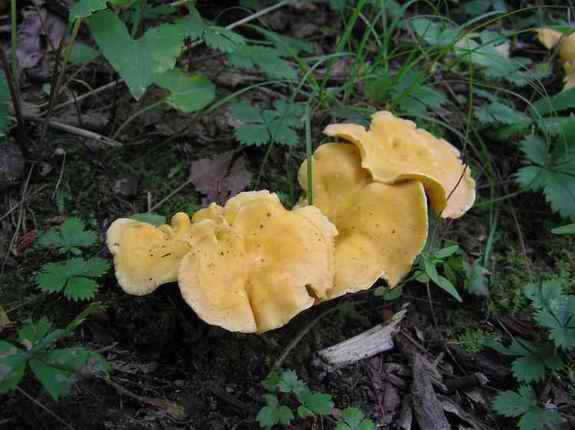|
Common Name: Chanterelle, Golden Chanterelle, Yellow Chanterelle Scientific Name: Cantharellus cibarius (Genus from the Greek kantharos and derivative Latin cantharus meaning cup, goblet or drinking vessel and referring to the trumpet-shape of the stalk; cibarius is Latin for "relating to food."
The chanterelle is recognized by mycophagists (fungus eaters) worldwide as one of the most succulent of the edible forest mushrooms. The literal translation of the species as "cup of food" attests to this association. Its popularity is due not only to its unique floral flavor and apricot aroma but to the facility with which it can be identified. Chanterelles have one distinctive identifying feature that sets them apart from other mushrooms. They do not have true, blade-like gills on the hymenium, the spore-bearing surface of the mushroom on the underside of the cap (pileus) like the familiar button mushroom, Agaricus bisporus. Rather, they have blunt ridges that run from the edge of the pileus down on the stalk (stipe), a configuration known as decurrent.
Chanterelles are also easily identified by the cornucopia shape of the stalk, by the rich yellow-orange coloration of the cap, and by the irregular shape of the cap margin. There is only one other mushroom that bears a likeness to the chanterelle as it is also yellow-orange in color, the poisonous Jack O'Lantern (Omphalotus olearius). Cursory examination would serve to prevent misidentification, as the latter has true gills in lieu of ridges and is generally found in clumps at the base of trees whereas the Chanterelle grows singly in scattered groups on the ground.
Chanterelles are nutritious; 100 grams, about 20 mushrooms, contain 0.4 grams of fat, 7 grams of carbohydrates, 2.6 grams of fiber and 34 calories. Analyses of amino acid content have shown that chanterelles are 10 percent protein by dry weight. They are rich in vitamins A and D and supply the minerals selenium, potassium, iron and phosphorous. Vitamin A in chanterelles is from carotenoids that are the source of the yellow pigmentation; improved visual acuity is realized when they are consumed. Vitamin D is synthesized when the mushroom tissues are illuminated with sunlight. Chanterelles can store vitamin D when dried for up to 6 years. Next to cod liver oil, chanterelles are one of the most concentrated sources of vitamin D; their popularity in the low sunlight northern reaches of Europe is in all probability a result of this.
The chanterelle was first mentioned in European literature by the Dutch herbalist Lobelius in 1581 and was the subject of a scientific monograph by the Belgian botanist Clusius in 1601. The many local common names for the mushroom throughout Europe imply an early medieval association. The chanterelle is capo gallo (cock's crest) in Italy, dotterpilz (egg yolk mushroom) in Germany, rebozuelo (woman's dress) in Spain, canarinhos (canary bird chicken) in Portugal, and jaunette (little yellow) or chanterelle in France. Linnaeus, the Swedish father of taxonomy, originally named the chanterelle Agaricus chantarellus in 1747, as it was a common edible. However, Elias Fries, the reputed father of mycology for his early work on the taxonomy of fungi, gave the chanterelle its current name Cantharellus cibarius in his 1832 work Systema Mycologicum.
Commercial cultivation of chanterelles is impractical, as they are ectomycorrhizal; they must grow with trees. The term mycorrhizal is derived from the Greek mykes meaning fungus and rhiza meaning root so the word literally translates as "fungus root". It refers to the symbiotic relationship between some fungi and plants, most notably trees. The hyphae, which are the threadlike filaments of the fungal mycelium (the underground fungal body), extend into the soil to absorb water and minerals that are provided to the host plant, thereby effectively extending its root system. In return, the plant provides carbohydrate nutrients to the fungus for growth and reproduction. The prefix "ecto" is derived from the Greek ektos meaning outside. This refers to those mycorrhizal fungi, like the chanterelles, that form external sheaths over the roots of the host plant to facilitate exchange of minerals and nutrients. The chanterelle is ectomycorrhizal with trees in 14 genera, notably oaks, pines, firs, spruces and hemlocks. Since they are not grown commercially, they are harvested in the wild for income in many regions.
It is estimated that the global market for chanterelles is about 450 million pounds and $1.4 Billion annually. Germany and France are the largest chanterelle importers in Europe; Poland, Lithuania, Russia, Belarus and Latvia are the biggest exporters. In Sweden, income from selling chanterelles is tax free up to $555 per person and it is estimated that 40 percent of the population picks mushrooms, mostly chanterelles, which they sell for about $10 per pound. There is reportedly a training manual for dogs to teach them to find chanterelles. In China, the chanterelle is called jiyou-jun (chicken fat mushroom) and is used both as foodstuff and as medicine. It is used to treat night blindness and as a lubricant to soothe rough, dry skin and to moisten mucous membranes. |
